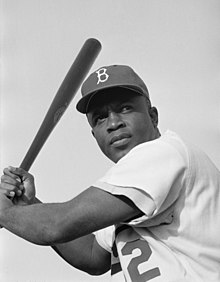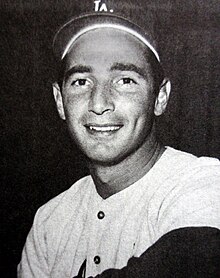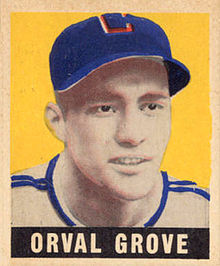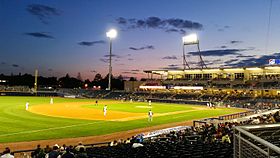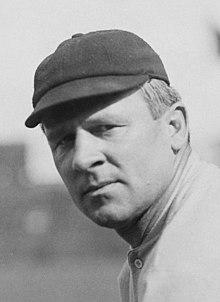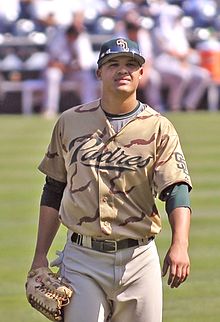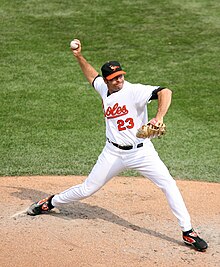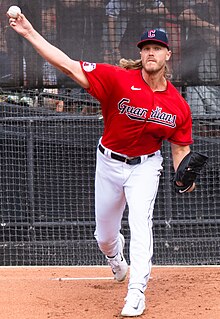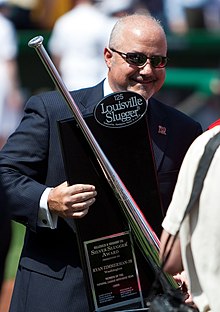Portal:Baseball
Portal maintenance status: (June 2018)
|
| Main page | Content, Categories & Topics | WikiProjects & Things you can do |
The Baseball Portal
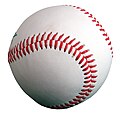
Baseball is a bat-and-ball sport played between two teams of nine players each, taking turns batting and fielding. The game occurs over the course of several plays, with each play generally beginning when a player on the fielding team, called the pitcher, throws a ball that a player on the batting team, called the batter, tries to hit with a bat. The objective of the offensive team (batting team) is to hit the ball into the field of play, away from the other team's players, allowing its players to run the bases, having them advance counter-clockwise around four bases to score what are called "runs". The objective of the defensive team (referred to as the fielding team) is to prevent batters from becoming runners, and to prevent runners' advance around the bases. A run is scored when a runner legally advances around the bases in order and touches home plate (the place where the player started as a batter).
The opposing teams switch back and forth between batting and fielding; the batting team's turn to bat is over once the fielding team records three outs. One turn batting for each team constitutes an inning. A game is usually composed of nine innings, and the team with the greater number of runs at the end of the game wins. Most games end after the ninth inning, but if scores are tied at that point, extra innings are usually played. Baseball has no game clock, though some competitions feature pace-of-play regulations such as the pitch clock to shorten game time.
Baseball evolved from older bat-and-ball games already being played in England by the mid-18th century. This game was brought by immigrants to North America, where the modern version developed. Baseball's American origins, as well as its reputation as a source of escapism during troubled points in American history such as the American Civil War and the Great Depression, have led the sport to receive the moniker of "America's Pastime"; since the late 19th century, it has been unofficially recognized as the national sport of the United States, though in modern times is considered less popular than other sports, such as American football. In addition to North America, baseball spread throughout the rest of the Americas and the Asia–Pacific in the 19th and 20th centuries, and is now considered the most popular sport in parts of Central and South America, the Caribbean, and East Asia, particularly in Japan, South Korea, and Taiwan. (Full article...)
 Featured articles - load new batch
Featured articles - load new batch
-
Image 1
Harmon Clayton Killebrew Jr. (/ˈkɪlɪbruː/; June 29, 1936 – May 17, 2011), nicknamed "the Killer" and "Hammerin' Harmon", was an American professional baseball first baseman, third baseman, and left fielder. He spent most of his 22-year career in Major League Baseball (MLB) with the Minnesota Twins. A prolific power hitter, Killebrew had the fifth-most home runs in major league history at the time of his retirement. He was second only to Babe Ruth in American League (AL) home runs, and was the AL career leader in home runs by a right-handed batter. Killebrew was inducted into the National Baseball Hall of Fame in 1984.
Killebrew was 5-foot-11-inch (180 cm) tall and 213 pounds (97 kg). His compact swing generated tremendous power and made him one of the most feared power hitters of the 1960s, when he hit at least 40 home runs per season eight times. In total Killebrew led the league six times in home runs and three times in RBIs, and was named to 13 All-Star teams. In 1965, he played in the World Series with the Twins, who lost to the Los Angeles Dodgers. His finest season was 1969, when he hit 49 home runs, recorded 140 RBIs and won the AL Most Valuable Player Award while helping lead the Twins to the AL West pennant. (Full article...) -
Image 2

Ian Michael Chappell (born 26 September 1943) is a former cricketer who played for South Australia and Australia. Known as "Chappelli", he is considered as one of the greatest captains the game has seen. He captained Australia between 1971 and 1975 before taking a central role in the breakaway World Series Cricket organisation. Born into a cricketing family—his grandfather and brother also captained Australia—Chappell made a hesitant start to international cricket playing as a right-hand middle-order batsman and spin bowler. He found his niche when promoted to bat at number three. Chappell's blunt verbal manner led to a series of confrontations with opposition players and cricket administrators; the issue of sledging first arose during his tenure as captain, and he was a driving force behind the professionalisation of Australian cricket in the 1970s. He was the captain of the Australian squad which finished as runners-up at the 1975 Cricket World Cup.
John Arlott called him "a cricketer of effect rather than the graces". An animated presence at the batting crease, he constantly adjusted his equipment and clothing, and restlessly tapped his bat on the ground as the bowler ran in. Basing his game on a sound defence learned during many hours of childhood lessons, Chappell employed the drive and square cut to full effect. He had an idiosyncratic method of playing back and across to a ball of full length and driving wide of mid-on, but his trademark shot was the hook, saying "three bouncers an over should be worth 12 runs to me". A specialist slip fielder, he was the fourth player to take one hundred Test catches. (Full article...) -
Image 3
Derek Sanderson Jeter (/ˈdʒiːtər/ JEE-tər; born June 26, 1974) (Nicknamed "The Captain") is an American former professional baseball shortstop, businessman, and baseball executive. As a player, Jeter spent his entire 20-year Major League Baseball (MLB) career with the New York Yankees. He was elected to the Baseball Hall of Fame in his first year of eligibility in 2020; he received 396 of 397 possible votes (99.75%), the second-highest percentage in MLB history (behind only teammate Mariano Rivera) and the highest by a position player. He was the chief executive officer (CEO) and part owner of the league's Miami Marlins from September 2017 to February 2022.
A five-time World Series champion with the Yankees, Jeter is regarded as a central contributor to the franchise's dynasty during the late 1990s and early 2000s for his hitting, base-running, fielding, and leadership. He is the Yankees' all-time career leader in hits (3,465), doubles (544), games played (2,747), stolen bases (358), times on base (4,716), plate appearances (12,602) and at bats (11,195). His accolades include 14 All-Star selections, five Gold Glove Awards, five Silver Slugger Awards, two Hank Aaron Awards, and a 2009 Roberto Clemente Award. Jeter was the 28th player to reach 3,000 hits and finished his career ranked sixth in MLB history in career hits and first among shortstops. In 2017, the Yankees retired his uniform number 2. (Full article...) -
Image 4
Charles Dillon "Casey" Stengel (/ˈstɛŋɡəl/; July 30, 1890 – September 29, 1975) was an American Major League Baseball right fielder and manager, best known as the manager of the championship New York Yankees of the 1950s and later, the expansion New York Mets. Nicknamed "the Ol' Perfessor", he was elected to the Baseball Hall of Fame in 1966.
Stengel was born in Kansas City, Missouri, in 1890. In 1910, he began a professional baseball career that would span over half a century. After almost three seasons in the minor leagues, Stengel reached the major leagues late in 1912, as an outfielder, for the Brooklyn Dodgers. His six seasons there saw some success, among them playing for Brooklyn's 1916 National League championship team, but he also developed a reputation as a clown. After repeated clashes over pay with the Dodgers owner, Charlie Ebbets, Stengel was traded to the Pittsburgh Pirates in 1918; however, he enlisted in the Navy that summer, for the remainder of World War I. After returning to baseball, he continued his pay disputes, resulting in trades to the Philadelphia Phillies (in 1919) and to the New York Giants (in 1921). There, he learned much about baseball from the manager, John McGraw, and had some of the glorious moments in his career, such as hitting an inside-the-park home run in Game 1 of the 1923 World Series to defeat the Yankees. His major league playing career ended with the Boston Braves in 1925, but he then began a career as a manager. (Full article...) -
Image 5
Arthur Joseph Houtteman (August 7, 1927 – May 6, 2003) was an American right-handed pitcher in Major League Baseball who played for 12 seasons in the American League with the Detroit Tigers, Cleveland Indians and Baltimore Orioles. In 325 career games, Houtteman pitched 1,555 innings and posted a win–loss record of 87–91, with 78 complete games, 14 shutouts, and a 4.14 earned run average (ERA).
Known on the sandlot for his pitching motion, Houtteman was signed by scout Wish Egan in 1945 at 17 years of age. He was recruited by major league teams, and joined a Tigers pitching staff that had lost players to injuries and World War II. After moving between the major and minor leagues over the next few years, he was nearly killed in an automobile accident just before the 1949 season. Houtteman rebounded from his injuries and went on to win 15 games that season and made his only All-Star appearance in the following year. (Full article...) -
Image 6
Jack Roosevelt Robinson (January 31, 1919 – October 24, 1972) was an American professional baseball player who became the first African-American to play in Major League Baseball (MLB) in the modern era. Robinson broke the color line when he started at first base for the Brooklyn Dodgers on April 15, 1947. The Dodgers signing Robinson heralded the end of racial segregation in professional baseball, which had relegated black players to the Negro leagues since the 1880s.
Born in Cairo, Georgia, Robinson was raised in Pasadena, California. A four-sport student athlete at Pasadena Junior College and the University of California, Los Angeles, he was better known for football than he was for baseball, becoming a star college player with the UCLA Bruins football team. Following his college career, Robinson was drafted for service during World War II but was court-martialed for refusing to sit at the back of a segregated Army bus, eventually being honorably discharged. Afterwards, he signed with the Kansas City Monarchs of the Negro leagues, where he caught the eye of Branch Rickey, general manager of the Brooklyn Dodgers, who thought he would be the perfect candidate for breaking the color line in MLB. (Full article...) -
Image 7
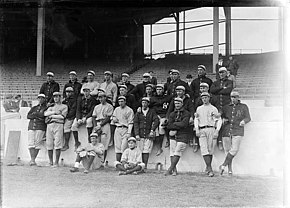
The 1913 squad, the first that went by the name "Yankees"
The history of the New York Yankees Major League Baseball (MLB) team spans more than a century. Frank J. Farrell and William Stephen Devery bought the rights to an American League (AL) club in New York City after the 1902 season. The team, which became known as the Yankees in 1913, rarely contended for the AL championship before the acquisition of outfielder Babe Ruth after the 1919 season. With Ruth in the lineup, the Yankees won their first AL title in 1921, followed by their first World Series championship in 1923. Ruth and first baseman Lou Gehrig were part of the team's Murderers' Row lineup, which led the Yankees to a then-AL record 110 wins and a Series championship in 1927 under Miller Huggins. They repeated as World Series winners in 1928, and their next title came under manager Joe McCarthy in 1932.
The Yankees won the World Series every year from 1936 to 1939 with a team that featured Gehrig and outfielder Joe DiMaggio, who recorded a record hitting streak during New York's 1941 championship season. New York set a major league record by winning five consecutive championships from 1949 to 1953, and appeared in the World Series nine times from 1955 to 1964. Mickey Mantle, Yogi Berra, and Whitey Ford were among the players fielded by the Yankees during the era. After the 1964 season, a lack of effective replacements for aging players caused the franchise to decline on the field, and the team became a money-loser for owners CBS while playing in an aging stadium. (Full article...) -
Image 8
Michael Jeffrey Jordan (born February 17, 1963), also known by his initials MJ, is an American businessman and former professional basketball player. He played 15 seasons in the National Basketball Association (NBA) between 1984 and 2003, winning six NBA championships with the Chicago Bulls. He was integral in popularizing basketball and the NBA around the world in the 1980s and 1990s, becoming a global cultural icon. His profile on the NBA website states, "By acclamation, Michael Jordan is the greatest basketball player of all time."
Jordan played college basketball with the North Carolina Tar Heels. As a freshman, he was a member of the Tar Heels' national championship team in 1982. Jordan joined the Bulls in 1984 as the third overall draft pick and quickly emerged as a league star, entertaining crowds with his prolific scoring while gaining a reputation as one of the best defensive players. His leaping ability, demonstrated by performing slam dunks from the free-throw line in Slam Dunk Contests, earned him the nicknames "Air Jordan" and "His Airness". Jordan won his first NBA title with the Bulls in 1991 and followed that achievement with titles in 1992 and 1993, securing a three-peat. Citing "physical and mental exhaustion" from basketball and superstardom, Jordan abruptly retired from basketball before the 1993–94 NBA season to play Minor League Baseball in the Chicago White Sox organization. He returned to the Bulls in March 1995 and led them to three more championships in 1996, 1997, and 1998, as well as a then-record 72 regular season wins in the 1995–96 NBA season. Jordan retired for the second time in January 1999, returning for two more NBA seasons from 2001 to 2003 as a member of the Washington Wizards. He was selected to play for the United States national team during his college and NBA careers, winning four gold medals—at the 1983 Pan American Games, 1984 Summer Olympics, 1992 Tournament of the Americas and 1992 Summer Olympics—while also being undefeated. (Full article...) -
Image 9

WSNS-TV (channel 44) is a television station in Chicago, Illinois, United States, serving as the local outlet for the Spanish-language network Telemundo. It is owned and operated by NBCUniversal's Telemundo Station Group alongside NBC outlet WMAQ-TV (channel 5). The two stations share studios at the NBC Tower on North Columbus Drive in the city's Streeterville neighborhood and broadcast from the same transmitter atop the Willis Tower in the Chicago Loop.
WSNS-TV began broadcasting in 1970. Originally specializing in the automated display of news headlines, it evolved into Chicago's third full-fledged independent station, carrying movies, local sports, and other specialty programming. This continued until 1980, when WSNS became the Chicago-area station for ON TV, an over-the-air subscription television (STV) service owned by Oak Industries, which took a minority ownership stake in the station. While ON TV was successful in Chicago and the subscription system became the second-largest in the country by total subscribers, the rise of cable television precipitated the end of the business in 1985, with WSNS-TV as the last ON TV station standing. (Full article...) -
Image 10
Sanford Koufax (/ˈkoʊfæks/; né Braun; born December 30, 1935), nicknamed "the Left Arm of God", is an American former baseball pitcher who played 12 seasons in Major League Baseball (MLB) for the Brooklyn/Los Angeles Dodgers from 1955 to 1966. Widely regarded as one of the greatest pitchers in baseball history, Koufax was the first three-time winner of the Cy Young Award, each time winning unanimously and the only pitcher to do so when a single award was given for both the leagues; he was also named the National League Most Valuable Player in 1963. Retiring at the age of 30 due to chronic pain in his pitching elbow, Koufax was elected to the Baseball Hall of Fame in his first year of eligibility in 1972 at the age of 36, the youngest player ever elected.
Born in Brooklyn, New York, Koufax was primarily a basketball player in his youth and had pitched in only a few games before signing with the Brooklyn Dodgers at age 19. Due to the bonus rule he signed under, Koufax never pitched the minor leagues. His lack of pitching experience caused manager Walter Alston to distrust Koufax who saw inconsistent playing time during his first six seasons. As a result, though he often showed flashes of brilliance, Koufax struggled early on. Frustrated with the way he was being managed by the Dodgers, he almost quit after the 1960 season. After making adjustments prior to the 1961 season, Koufax quickly rose to become the most dominant pitcher in the major leagues, as well as the first major sports star on the West Coast. He was an All-Star in each of his last six seasons, leading the National League (NL) in earned run average each of his last five years, in strikeouts four times, and in wins and shutouts three times each. He was the first pitcher in the live-ball era to post an earned run average below 2.00 in three different qualifying seasons, and the first ever to record a 300-strikeout season three times. (Full article...) -
Image 11
Orval Leroy Grove (August 29, 1919 – April 20, 1992) was an American professional baseball pitcher in Major League Baseball who played for ten seasons in the American League with the Chicago White Sox. In 207 career games, Grove pitched 1,176 innings and posted a win–loss record of 63–73, with 66 complete games, 11 shutouts, and a 3.78 earned run average (ERA).
The only freshman on the Proviso Township High School varsity baseball team, Grove's pitching ability attracted the attention of the White Sox. After signing with the team in 1937, Grove moved between the major leagues and minor leagues for a few seasons until 1943, when he found a solid place in the White Sox's pitching rotation. Grove had a career-year in 1943, finishing the season with career-bests in ERA, wins, and complete games; in 1944, he made his only All-Star appearance. (Full article...) -
Image 12
First Horizon Park, formerly known as First Tennessee Park, is a baseball park in downtown Nashville, Tennessee, United States. The home of the Triple-A Nashville Sounds of the International League, it opened on April 17, 2015, and can seat up to 10,000 people. It replaced the Sounds' former home, Herschel Greer Stadium, where the team played from its founding in 1978 through 2014.
The park was built on the site of the former Sulphur Dell, a minor league ballpark in use from 1885 to 1963. It is located between Third and Fifth Avenues on the east and west (home plate, the pitcher's mound, and second base are directly in line with Fourth Avenue to the stadium's north and south) and between Junior Gilliam Way and Harrison Street on the north and south. The Nashville skyline can be seen from the stadium to the south. (Full article...) -
Image 13
Robert William Meusel (July 19, 1896 – November 28, 1977) was an American baseball left and right fielder who played in Major League Baseball (MLB) for eleven seasons from 1920 through 1930, all but the last for the New York Yankees. He was best known as a member of the Yankees' championship teams of the 1920s, nicknamed "Murderers' Row", during which time the team won its first six American League (AL) pennants and first three World Series titles.
Meusel, noted for his strong outfield throwing arm, batted fifth behind Baseball Hall of Famers Babe Ruth and Lou Gehrig. In 1925, he became the second Yankee, after Ruth, to lead the AL in home runs (33), runs batted in (138) and extra base hits (79). Nicknamed "Long Bob" because of his 6-foot, 3 inch (1.91 m) stature, Meusel batted .313 or better in seven of his first eight seasons, finishing with a .309 career average; his 1,009 RBI during the 1920s were the fourth most by any major leaguer, and trailed only Harry Heilmann's total of 1,131 among AL right-handed hitters. Meusel ended his career in 1930 with the Cincinnati Reds. He hit for the cycle three times, and was the second of six major leaguers to accomplish this feat as many as three times during a career. (Full article...) -
Image 14
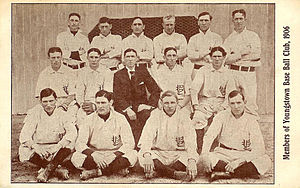
Youngstown Ohio Works (1906), with pitcher Roy Castleton seated in second row, second from left
The Youngstown Ohio Works baseball team was a minor league club that was known for winning the premier championship of the Ohio–Pennsylvania League in 1905, and for launching the professional career of pitcher Roy Castleton a year later. A training ground for several players and officials who later established careers in Major League Baseball, the team proved a formidable regional competitor and also won the 1906 league championship.
During its brief span of activity, the Ohio Works team faced challenges that reflected common difficulties within the Ohio–Pennsylvania League, including weak financial support for teams. Following a dispute over funding, the team's owners sold the club to outside investors, just a few months before the opening of the 1907 season. (Full article...) -
Image 15
John Joseph McGraw (April 7, 1873 – February 25, 1934) was an American Major League Baseball (MLB) player and manager who was for almost thirty years manager of the New York Giants. He was also the third baseman of the pennant-winning 1890s Baltimore Orioles teams, noted for their innovative, aggressive play.
McGraw was born into poverty in Truxton, New York. He found an escape from his hometown and a bad family situation through baseball, beginning a quick rise through the minor leagues that led him to the Orioles at the age of 18. Under the tutelage of manager Ned Hanlon, the Orioles of the 1890s won three National League (NL) pennants; McGraw was one of the stalwarts of the team alongside Wee Willie Keeler, Hughie Jennings, and Wilbert Robinson. The Orioles perfected the hit and run play and popularized the Baltimore chop; they also sought to win by intimidating the opposing team and the umpire. (Full article...)
General images - load new batch
-
Image 1A first baseman receives a pickoff throw, as the runner dives back to first base. (from Baseball)
-
Image 3Fenway Park, home of the Boston Red Sox. The Green Monster is visible beyond the playing field on the left. (from Baseball)
-
Image 4A runner sliding into home plate and scoring. (from Baseball)
-
Image 5A well-worn baseball (from Baseball)
-
Image 7An Afghan girl playing baseball in August 2002 (from Baseball)
-
Image 8Cy Young—the holder of many major league career marks, including wins and innings pitched, as well as losses—in 1908. MLB's annual awards for the best pitcher in each league are named for Young. (from Baseball)
-
Image 9A batter follows through after swinging at a pitched ball. (from Baseball rules)
-
Image 10The NL champion New York Giants baseball team, 1913. Fred Merkle, sixth in line, had committed a baserunning gaffe in a crucial 1908 game that became famous as Merkle's Boner. (from History of baseball)
-
Image 11Rickey Henderson—the major leagues' all-time leader in runs and stolen bases—stealing third base in a 1988 game (from Baseball)
-
Image 13The American Tobacco Company's line of baseball cards featured shortstop Honus Wagner of the Pittsburgh Pirates from 1909 to 1911. In 2007, the card shown here sold for $2.8 million. (from Baseball)
-
Image 14In May 2010, the Philadelphia Phillies' Roy Halladay pitched the 20th major league perfect game. That October, he pitched only the second no-hitter in MLB postseason history. (from History of baseball)
-
Image 15A pitcher handing off the ball after being taken out of the game during a mound meeting. (from Baseball)
-
Image 16Jackie Robinson in 1945, with the era's Kansas City Royals, a barnstorming squad associated with the Negro American League's Kansas City Monarchs (from Baseball)
-
Image 18Pitchers are generally substituted during mound visits (team gatherings at the pitcher's mound). (from Baseball rules)
-
Image 19Jackie Robinson in 1945, with the era's Kansas City Royals, a barnstorming squad associated with the Negro American League's Kansas City Monarchs (from History of baseball)
-
Image 20Sadaharu Oh managing the Japan national team in the 2006 World Baseball Classic. Playing for the Central League's Yomiuri Giants (1959–80), Oh set the professional world record for home runs. (from Baseball)
-
Image 21Cover of Official Base Ball Rules, 1921 edition, used by the American League and National League (from Baseball rules)
-
Image 24A game from the Cantigas de Santa Maria, c. 1280, involving tossing a ball, hitting it with a stick and competing with others to catch it (from History of baseball)
-
Image 25The strike zone, which determines the outcome of most pitches, varies in vertical length depending on the batter's typical height while swinging. (from Baseball rules)
-
Image 26A New York Yankees batter (Andruw Jones) and a Boston Red Sox catcher at Fenway Park (from Baseball)
-
Image 27Japanese-Americans spectating a World War II-era game while in an internment camp. America's ties to immigrants and to Japan have been deeply shaped by a shared baseball heritage. (from History of baseball)
-
Image 28Two players on the baseball team of Tokyo, Japan's Waseda University in 1921 (from Baseball)
-
Image 30Pick-off attempt on runner (in red) at first base (from Baseball rules)
-
Image 332013 World Baseball Classic championship match between the Dominican Republic and Puerto Rico, March 20, 2013 (from Baseball)
-
Image 34Defensive positions on a baseball field, with abbreviations and scorekeeper's position numbers (not uniform numbers) (from Baseball)
-
Image 35The typical motion of a right-handed pitcher (from Baseball rules)
-
Image 36Sadaharu Oh managing the Japan national team in the 2006 World Baseball Classic. Playing for the Central League's Yomiuri Giants (1959–80), Oh set the professional world record for home runs with 868. (from History of baseball)
-
Image 37The standard fielding positions (from Baseball rules)
-
Image 38The strike zone determines the result of most pitches, and varies in vertical length for each batter. (from Baseball)
-
Image 39Diagram of a baseball field Diamond may refer to the square area defined by the four bases or to the entire playing field. The dimensions given are for professional and professional-style games. Children often play on smaller fields. (from Baseball)
-
Image 40Pesäpallo, a Finnish variation of baseball, was invented by Lauri "Tahko" Pihkala in the 1920s, and after that, it has changed with the times and grown in popularity. Picture of Pesäpallo match in 1958 in Jyväskylä, Finland. (from Baseball)
-
Image 41Alexander Cartwright, father of modern baseball (from History of baseball)
-
Image 42By the 1860s Civil War, baseball (bottom) had overtaken its fellow bat-and-ball sport cricket (top) in popularity within the United States. (from History of baseball)
-
Image 43Baserunners generally stand a short distance away from their base between pitches, preparing themselves to either go back or steal the next base. (from Baseball rules)
-
Image 441906 World Series, infielders playing "in" for the expected bunt and the possible play at the plate with the bases loaded (from Baseball rules)
-
Image 45Baseball games sometimes end in a walk-off home run, with the batting team usually gathering at home plate to celebrate the scoring of the winning run(s). (from Baseball rules)
 Good articles - load new batch
Good articles - load new batch
-
Image 1
William Dion Venable (born October 29, 1982) is an American professional baseball coach and former player. He is the manager of the Chicago White Sox of Major League Baseball (MLB). He played in MLB as an outfielder for the San Diego Padres, Texas Rangers, and Los Angeles Dodgers. He also was a coach for the Chicago Cubs. He is the son of former MLB outfielder Max Venable and is the older brother of former National Football League player Winston Venable.
Venable played college basketball for Princeton, where he was the second athlete to earn first-team All-Ivy League honors in both baseball and basketball. In the 2005 MLB Draft, the Padres selected Venable in the seventh round; he made his major league debut in 2008. Although he broke into MLB as a center fielder, he played mostly as a right fielder after his second season. He finished among the top 10 in the National League in triples four times and in stolen bases twice. He has the most MLB career hits and home runs of any Princeton alumnus. (Full article...) -
Image 2
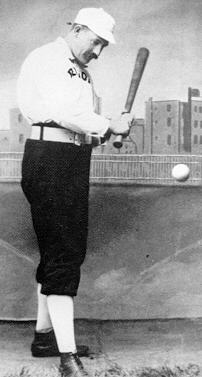
Dennis Joseph "Dan" Brouthers (/ˈbruːθərz/; May 8, 1858 – August 2, 1932) was an American first baseman in Major League Baseball whose career spanned the period from 1879 to 1896, with a brief return in 1904. Nicknamed "Big Dan" for his size, he was 6 feet 2 inches (1.88 m) and weighed 207 pounds (94 kg), which was large by 19th-century standards.
Recognized as the first great slugger in baseball history, and among the greatest sluggers of his era, he briefly held the career home run record from 1887 to 1889, with his final total of 106 tying for the fourth most of the 19th century. His career slugging percentage of .520 remained the Major League record until Babe Ruth overtook him in the 1920s. At the time of his initial retirement, he also ranked second in career triples (205), and third in runs batted in (1,296) and hits. (Full article...) -
Image 3Donald Eugene Eddy (October 25, 1946 – October 10, 2018) was an American Major League Baseball pitcher who played for the Chicago White Sox in 1970 and 1971. A native of Swaledale, Iowa, he batted right-handed but threw left-handed.
After playing American Legion Baseball and excelling on Rockwell-Swaledale High School's baseball team, Eddy was signed by the White Sox in 1965. Two years of service in the United States Army interrupted his minor league career, but he was called up by the White Sox in 1970. A member of their Opening Day roster in 1971, he posted a list of White Sox left-handers on his locker door, crossing names off each time he thought he had passed them on the depth chart. Optioned to the minor leagues in June, he rejoined the team for three games in September, his last in the major leagues. Overall, he had an 0–2 record and a 2.36 earned run average. Traded to the San Diego Padres in 1972, he finished his professional career in 1973. (Full article...) -
Image 4
Kenneth Lofton (born May 31, 1967) is an American former Major League Baseball (MLB) center fielder. Lofton was a six-time All-Star (1994–1999), four-time Gold Glove Award winner (1993–1996), and at retirement, was ranked 15th among all-time stolen base leaders with 622. During his career, he played for the Houston Astros, Cleveland Indians, Atlanta Braves, Chicago White Sox, San Francisco Giants, Pittsburgh Pirates, Chicago Cubs, New York Yankees, Philadelphia Phillies, Los Angeles Dodgers, and Texas Rangers.
Lofton attended the University of Arizona on a basketball scholarship. The Wildcats made it to the Final Four in 1988. He did not join the school's baseball team until his junior year. (Full article...) -
Image 5Charles Wilber Rogan, also known as "Bullet Joe" (July 28, 1893 – March 4, 1967), was an American pitcher, outfielder, and manager for the Kansas City Monarchs in the Negro baseball leagues from 1920 to 1938. Renowned as a two-way player who could both hit and pitch successfully, one statistical compilation shows Rogan winning more games than any other pitcher in Negro leagues history and ranking fourth highest in career batting average. He was elected to the Baseball Hall of Fame in 1998.
Rogan's early baseball career took place in the U.S. Army, where he played for a famous team in the all-black 25th Infantry. After joining the Kansas City Monarchs, he was the top pitcher and one of the best hitters on a team that won three pennants from 1923 to 1925 and the 1924 Colored World Series. He became a playing manager in 1926 and led his team to another league title in 1929. (Full article...) -
Image 6
David Eugene Clyde (born April 22, 1955) is a former left-handed Major League Baseball pitcher who played for five seasons with the Texas Rangers (1973–1975) and Cleveland Indians (1978–1979). He is noted for his once promising baseball career, which ended at age 26 because of arm and shoulder injuries.
Billed as the next Sandy Koufax, Clyde had a stellar high school career at Westchester High School. He was drafted with the first overall pick in the 1973 Major League Baseball draft. The Rangers planned to have Clyde pitch his first two professional games in the major leagues before moving him down to the minor leagues, but Rangers owner Bob Short decided to keep him in the roster for monetary purposes, where he had a 5.01 earned run average in 18 starts. Journalists criticized the Rangers for promoting Clyde too soon, and after an uneventful 1974 campaign, he developed shoulder trouble and was sent down to the minor leagues in 1975, where he pitched three seasons. He was traded to the Cleveland Indians in 1978, and played two seasons before being demoted. Clyde attempted to make a comeback with the Houston Astros but was unsuccessful. (Full article...) -
Image 7
Paul Kenneth Shuey (born September 16, 1970) is an American former professional baseball player. Primarily a relief pitcher, Shuey pitched in Major League Baseball (MLB) for the Cleveland Indians (1994–2002), Los Angeles Dodgers (2002–2003) and Baltimore Orioles (2007).
Shuey was honored as an All-American as a college baseball pitcher for the North Carolina Tar Heels baseball team. The Indians selected Shuey with the second overall selection of the 1992 MLB draft. Envisioned as a comparable pitcher to Cincinnati Reds closer Rob Dibble, Shuey had more success as a setup reliever than closer. (Full article...) -
Image 8The 2014 National League Wild Card Game was a play-in game during Major League Baseball's (MLB) 2014 postseason played between the National League's (NL) two wild card teams, the San Francisco Giants and the Pittsburgh Pirates. It was held at PNC Park in Pittsburgh, Pennsylvania, on October 1, 2014, starting at 8:07 p.m. EDT. After both teams finished the regular season with identical records of 88–74, the Pirates were awarded home field for the game, as they won the season series against the Giants, 4–2. Despite this advantage, the Giants won by a score of 8–0 and advanced to play the Washington Nationals in the NL Division Series. In addition to being the third NL Wild Card Game played, it is notable for the first postseason grand slam hit by a shortstop. The game was televised on ESPN, and was also broadcast on ESPN Radio. (Full article...)
-
Image 9Clarke playing for the Cleveland Naps
Jay Justin "Nig" Clarke (December 15, 1882 – June 15, 1949) was a Canadian professional baseball player. A catcher, Clarke played in Major League Baseball (MLB) for nine seasons with the Detroit Tigers, Cleveland Naps, St. Louis Browns, Philadelphia Phillies, and Pittsburgh Pirates. In 506 career games, Clarke recorded a batting average of .254 and accumulated 20 triples, six home runs, and 127 runs batted in (RBI).
Born in Canada and raised in Michigan, Clarke began his baseball career in 1902, when he reportedly hit eight home runs in one game while playing for the Corsicana Oil Citys of the Texas League. From there, he spent two more seasons in the minor leagues before the Cleveland Naps signed him to a contract. Aside from a loan to the Detroit Tigers, he played for the Naps for six seasons. Clarke was then traded to the St. Louis Browns, where he played for one season. After several years in the minor leagues, Clarke joined the United States Marine Corps. He returned to the major leagues and played there until 1920, then continued playing for minor league teams until 1927. Clarke then retired from the game, rejoined the Marines, and moved to River Rouge, Michigan, where he lived until his death in 1949. (Full article...) -
Image 10Shawn Patrick Sedlacek [sed′–la–check] (born June 29, 1977) is an American former professional baseball pitcher. He played part of one season in Major League Baseball (MLB), primarily as a starting pitcher, for the Kansas City Royals in 2002. Sedlacek threw a four-seam fastball, a two-seam fastball, a changeup, a slider, and a curveball.
Born in Cedar Rapids, Iowa, Sedlacek attended Iowa State University, leading the team with 65 strikeouts and 77 innings pitched as a senior before getting selected by the Royals in the 1998 MLB draft. Initially expected to be a relief pitcher, he became a starting pitcher during his first season due to injuries to other starters, and he would finish among the leaders in the minor leagues he pitched in over the next few years. The Royals called him up in June 2002 following injuries to Jeremy Affeldt and Paul Byrd, and he debuted for them on June 18. Sedlacek posted a 3.05 earned run average (ERA) in his first six starts but had a 10.10 ERA in his next eight and was moved to the bullpen in September. After pitching for Kansas City's minor league affiliates in 2003, he left the Royals organization and played for two years in the minors for several other teams and also in the independent Northern League. Remaining in the Kansas City area following his retirement, he is part of Complete Game Baseball, an organization that provides baseball training and fields its own teams. (Full article...) -
Image 11Syndergaard with the Cleveland Guardians in 2023
Noah Seth Syndergaard (born August 29, 1992), nicknamed "Thor", is an American professional baseball pitcher who is a free agent. He has played in Major League Baseball (MLB) for the New York Mets, Los Angeles Angels, Philadelphia Phillies, Los Angeles Dodgers, and Cleveland Guardians.
Born in Mansfield, Texas, Syndergaard did not establish himself as a baseball player for Mansfield Legacy High School until his senior year in 2010, where his pitch velocity was bolstered by a growth spurt and weight training regimen. Despite his strong season, Syndergaard's late development meant that he was mostly overlooked by scouts and college coaches, and he received only one college baseball scholarship offer. He turned down Dallas Baptist University, however, when the Toronto Blue Jays selected him in the first round, 38th overall, of the 2010 MLB Draft. After three years in the Blue Jays' farm system, Syndergaard was traded with several other prospects to the Mets in exchange for reigning Cy Young Award winner R. A. Dickey. He made back-to-back appearances in the All-Star Futures Game in 2013 and 2014, but was left off of the Mets' September call-up list. (Full article...) -
Image 12
Ned Franklin Garver (December 25, 1925 – February 26, 2017) was an American professional baseball player. He played in Major League Baseball (MLB) as a right-handed pitcher for the St. Louis Browns (1948–1952), the Detroit Tigers (1952–1956), the Kansas City Athletics (1957–1960), and the Los Angeles Angels (1961). Garver and Irv Young are the only pitchers in the modern era of baseball (since 1901) to win 20 or more games for a team that lost 100 games.
A native of Ney, Ohio, Garver grew up rooting for the Tigers. Signed by the Browns in 1944, he reached the major leagues with the team in 1948. Poor run support contributed to his tying for the American League (AL) lead with 17 losses in 1949. However, in 1951, he posted a 20–12 record for the ballclub, during a season in which the Browns had a 52–102 record. Casey Stengel picked him to start the All-Star Game that year. (Full article...) -
Image 13
Brad Martin Hennessey (born February 7, 1980) is an American former professional baseball pitcher. He played in Major League Baseball (MLB) for the San Francisco Giants. He stands 6 feet 2 inches (1.88 m) tall and weighs 185 pounds (84 kg). He played for the Giants from 2004 to 2008 and threw five pitches: a fastball, a slider, a changeup, a curveball, and a cutter.
Hennessey attended Youngstown State University and set several school records during his tenure with the team. In 2001, he was selected by the Giants in the first round of the draft. He did not pitch in 2002 because of surgery to remove a non-cancerous tumor from his back. In 2004, he reached the major leagues for the first time. He spent much of the 2005 season in the major leagues, making 21 starts and posting a 4.64 earned run average (ERA). In 2006, Hennessey spent time both in the Giants' starting rotation and the bullpen. He became a relief pitcher full-time in 2007, spending the entire season in the majors and closing for the Giants part of the time. After posting a 7.81 ERA with the Giants in 2008, Hennessey was outrighted to the minors; he refused the assignment and became a free agent. He attempted to pitch for the Baltimore Orioles in 2009 but was unable due to injury. Hennessey then spent parts of 2010 and 2011 in the minor leagues. (Full article...) -
Image 14

Duff Gordon "Sir Richard" Cooley (March 29, 1873 – August 9, 1937) was an American professional baseball player whose career spanned 17 seasons, 13 of which were spent in Major League Baseball (MLB). Cooley, an outfielder and first baseman, had a career batting average of .294 in 1,317 games played. He compiled 849 runs, 1,579 hits, 180 doubles, 102 triples, 26 home runs, and 557 runs batted in (RBI). In Major League history, he is tied in 148th place for most all-time triples and, his 224 career stolen bases, place him equal 279th on the all-time list. Cooley made his Major League debut at the age of 20, and spent the majority of his career there, but he also appeared in minor league baseball. After breaking his leg with the Tigers in 1905, he was replaced with future Hall of Fame outfielder Ty Cobb. Cooley, nicknamed "Sir Richard" due to his aristocratic manner, was listed as standing 5 feet 11 inches (180 cm) and weighing 158 pounds (72 kg). (Full article...) -
Image 15
Bradley Austin Miller (born October 18, 1989) is an American professional baseball utility player who is a free agent. He has previously played in Major League Baseball (MLB) for the Seattle Mariners, Tampa Bay Rays, Milwaukee Brewers, Cleveland Indians, Philadelphia Phillies, St. Louis Cardinals, and Texas Rangers.
Miller grew up playing Little League baseball in Windermere, Florida, before attending Olympia High School, where he served as the team's shortstop. Although the Texas Rangers selected him in the 2008 MLB Draft, Miller chose to play college baseball for the Clemson Tigers. As a junior in 2011, he won the Brooks Wallace Award, given annually to the best shortstop in college baseball. Miller was also named twice to the United States national collegiate baseball team, including appearances at the 2009 World Baseball Challenge and the 2010 World University Baseball Championship. (Full article...)
Did you know (auto-generated) - load new batch

- ... that Brewer Hicklen hosts an annual youth baseball camp in Alabama?
- ... that Cam Booser retired from baseball to work as a carpenter in 2017 and made it to Major League Baseball in 2024?
- ... that Frankie Saluto was a member of the Ringling Giants, a dwarf baseball team that raised money for charity?
- ... that Amanda Asay was the longest-serving member of the Canadian women's baseball team when she died at 33, having played on the team for sixteen years?
- ... that Domingo Germán was booed off the pitcher's mound in the game prior to his perfect game?
- ... that Major League Baseball set a single-day record with $1.4 billion in new player contracts the day before the 2021 lockout was set to begin?
- ... that the only run scored by John Gamble was a game-winner?
- ... that Jenny Cavnar is the first female primary play-by-play announcer in Major League Baseball history?
Quotes
| Fans, for the past two weeks you have been reading about a bad break I got. Yet today, I consider myself the luckiest man on the face of the earth. I have been in ballparks for 17 years, and I have never received anything but kindness and encouragement from you fans. Look at these grand men. Which of you wouldn't consider it the highlight of his career just to associate with them for even one day?
— Lou Gehrig, speech made on Lou Gehrig Appreciation Day at Yankee at Yankee Stadium (July 4, 1939)
|
 Featured lists - load new batch
Featured lists - load new batch
-
Image 1
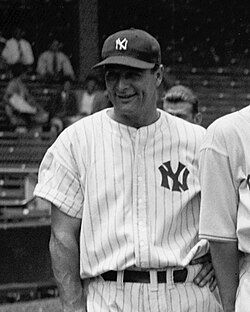
Lou Gehrig briefly held the single-season RBI record with his 175 in 1927 before Hack Wilson topped this total with 191 in 1930. In total Gehrig was responsible for three of the nine seasons in which a player hit 170 or more RBI.
In baseball, a run batted in (RBI) is awarded to a batter for each runner who scores as a result of the batter's action, including a hit, fielder's choice, sacrifice fly, bases loaded walk, or hit by pitch. A batter is also awarded an RBI for scoring himself upon hitting a home run. However, if a run scores because of an error that the defense commits on a batted ball, the batter does not (in most cases) receive an RBI; the exception is when the official scorer deems the run would've scored with or without an error, such as when an error occurs on a fielder's choice.
In Major League Baseball (MLB), a player in each league[L] wins the "RBI crown" or "RBI title" each season by hitting the most runs batted in that year. The first RBI champion in the National League (NL) was Deacon White; in the league's inaugural 1876 season, White hit 60 RBIs for the Chicago White Stockings. The American League (AL) was established in 1901, and Hall of Fame second baseman Nap Lajoie led that league with 125 RBIs for the Philadelphia Athletics. Over the course of his 27-season career, Cap Anson led the NL in RBI eight times. Babe Ruth and Honus Wagner have the second- and third-most RBI titles, respectively: Ruth with six, and Wagner with five. Several players are tied for the most consecutive seasons led with three: Anson (twice), Ty Cobb, Rogers Hornsby, Ruth, Joe Medwick, George Foster, and Cecil Fielder. Notably, Matt Holliday won the NL title in 2007 by one RBI over Ryan Howard, only overtaking Howard due to his performance in the 2007 National League Wild Card tie-breaker game. Had Howard won the 2007 title, he would have led the NL in a record four consecutive seasons from 2006 to 2009. The most recent champions are Kyle Tucker in the American League, and Matt Olson in the National League. (Full article...) -
Image 2Tip O'Neill, the namesake of the award
The Tip O'Neill Award is given annually to a Canadian baseball player who is "judged to have excelled in individual achievement and team contribution while adhering to the highest ideals of the game of baseball." The award was created by the Canadian Baseball Hall of Fame and first presented in 1984. It is named after James "Tip" O'Neill, one of the earliest Canadian stars in Major League Baseball (MLB).
Larry Walker, Jason Bay, Joey Votto, and Justin Morneau are the only players to win the Tip O'Neill Award at least three times. Walker won the award nine times, and Votto has won it seven times. Six winners – Walker, Bay, Terry Puhl, Rob Ducey, Ryan Dempster, and Corey Koskie – are members of the Canadian Baseball Hall of Fame. The award has been presented to one amateur player, Daniel Brabant. Walker, Votto, and Justin Morneau won the MLB Most Valuable Player (MVP) Award alongside the Tip O'Neill Award; the trio are the only Canadians to win the MLB MVP Award. Éric Gagné, the 2002 and 2003 recipient, compiled a major league record of 84 consecutive save opportunities converted from 2002 to 2004 and won the Cy Young Award in 2003. He and John Axford went on to win the Rolaids Relief Man Award in the same year as the Tip O'Neill Award. Bay became the first Canadian to win the Rookie of the Year Award, which he won the same year he won his first Tip O'Neill Award. Votto is the only award winner to also win the Hank Aaron Award. (Full article...) -
Image 3

Greg Maddux has won 18 Gold Gloves, the most in Major League Baseball history.
The Gold Glove Award is the award given annually to the Major League Baseball players judged to have exhibited superior individual fielding performances at each fielding position in both the National League (NL) and the American League (AL), as voted by the managers and coaches in each league. Managers are not permitted to vote for their own players. Eighteen Gold Gloves are awarded each year (with the exception of 1957, 1985, 2007 and 2018), one at each of the nine positions in each league. In 1957, the baseball glove manufacturer Rawlings created the Gold Glove Award to commemorate the best fielding performance at each position. The award was created from a glove made from gold lamé-tanned leather and affixed to a walnut base. Initially, only one Gold Glove per position was awarded to the top fielder at each position in the entire league; however, separate awards were given for the National and American Leagues beginning in 1958.
Greg Maddux has won the most Gold Glove Awards among all players, including pitchers, in Major League Baseball history. He won 18 awards, all in the National League; his streak of wins was consecutive from 1990 through 2002 until interrupted by Mike Hampton in 2003. Maddux won five more awards from 2004 to 2008, after which he retired. Jim Kaat is second and held the record for most wins (16) until he was displaced by Maddux in 2007. He won 14 awards in the American League and 2 in the National League; his 16 consecutive awards is a record among winners. Bob Gibson won nine Gold Gloves with the St. Louis Cardinals, and the inaugural winner Bobby Shantz won four awards in each league, for a total of eight. Mark Langston and Mike Mussina are tied for the fifth-highest total, with seven wins each. Zack Greinke currently ranks seventh with six wins. Gold Glove winners at pitcher who have been inducted into the Baseball Hall of Fame include Gibson, Kaat, Mussina, Maddux, Steve Carlton, Jim Palmer, and Phil Niekro. (Full article...) -
Image 4

Eddie Guardado, a pitcher for the 1993 Xpress, was called up after 10 starts to make his MLB debut with the Minnesota Twins on June 13, 1993.
The Nashville Xpress Minor League Baseball team played two seasons in Nashville, Tennessee, from 1993 to 1994 as the Double-A affiliate of the Minnesota Twins. In those seasons, a total of 60 players competed in at least one game for the Xpress. The 1993 roster included a total of 35 players, while 38 played for the team in 1994. There were 13 players who were members of the team in both seasons. Of the 60 all-time Xpress players, 22 also played in at least one game for a Major League Baseball (MLB) team during their careers.
After the 1992 baseball season, Charlotte, North Carolina, home of the Double-A Southern League's Charlotte Knights, acquired a Triple-A expansion team in the International League, leaving the Southern League franchise in need of a new home. Larry Schmittou, president of the Triple-A Nashville Sounds, offered Herschel Greer Stadium as a temporary home for the displaced team until owner George Shinn could find a permanent home for his club. Upon the league's approval, the franchise relocated to Nashville and became the Nashville Xpress. In order to accommodate two teams at Greer, the Xpress' games were scheduled for during the Sounds' road trips. (Full article...) -
Image 5Major League Baseball presents a variety of annual awards and trophies to recognize both its teams and its players. Three team trophies are awarded annually: one each to the National League and American League champions, and one of the champion of the World Series. Additionally, various organizations—such as the Baseball Writers' Association of America (BBWAA) and the Office of the Commissioner of Baseball—present awards for such accomplishments as excellence in batting, pitching performance, fielding prowess, and community service.
The Most Valuable Player Award, commonly known as the "MVP", is the oldest individual award, given in its current format since 1931. MVP awards are also presented for performances in the Major League Baseball All-Star Game, the League Championship Series, and the World Series. Offensive awards include the Silver Slugger Award and the Hank Aaron Award, while the Cy Young Award and Major League Baseball Reliever of the Year Award recognize pitching; the Rawlings Gold Glove Award is given for fielding. The newest award is the All-MLB Team, introduced in 2019 to honor the best players at each position across all of MLB. Before that time, the most recently established awards were the Major League Baseball Reliever of the Year Award and Major League Baseball Comeback Player of the Year Award, both established in 2005. Additionally, the Commissioner, at his discretion, can present an Historic Achievement Award for any great contribution to the sport that he deems worthy. (Full article...) -
Image 6

In baseball, a home run is credited to a batter when he hits a fair ball and reaches home safely on the same play, without the benefit of an error. Sixty-two different players have hit two home runs in an inning of a Major League Baseball (MLB) game to date, the most recent being Brent Rooker of the Oakland Athletics on May 4, 2024. Regarded as a notable achievement, five players have accomplished the feat more than once in their career; no player has ever hit more than two home runs in an inning. Charley Jones was the first player to hit two home runs in one inning, doing so for the Boston Red Stockings against the Buffalo Bisons on June 10, 1880.
These innings have resulted in other single-inning and single-game MLB records being set due to the prodigious offensive performance. Bobby Lowe and Mike Cameron finished their respective games with a total of four home runs, equaling the record for most home runs in one game. Both of the home runs hit by Fernando Tatís in the third inning for the St. Louis Cardinals on April 23, 1999, were grand slams. Not only did he tie the record for most grand slams in one game, Tatís became the only player to hit two grand slams in the same inning and established a new major league record with eight runs batted in (RBI) in a single inning. A decade later, Alex Rodriguez set the single-inning American League record for RBIs with seven when he hit a three-run home run and a grand slam in the sixth inning for the New York Yankees on October 4, 2009. (Full article...) -
Image 7

Carlos Zambrano was the Cubs' Opening Day starting pitcher from 2005 to 2010.
The Chicago Cubs are a Major League Baseball franchise based in Chicago that plays in the National League Central division. In the history of the franchise, it has also played under the names Chicago White Stockings, Chicago Colts and Chicago Orphans. The first game of the new baseball season for a team is played on Opening Day, and being named the Opening Day starter is an honor, which is often given to the player who is expected to lead the pitching staff that season, though there are various strategic reasons why a team's best pitcher might not start on Opening Day. The Cubs have used 68 different starting pitchers on Opening Day since they first became a Major League team in 1876. The Cubs have a record of 74 wins, 60 losses and 2 ties in their Opening Day games.
The Cubs have played in seven different home ball parks. They have played at their current home, Wrigley Field, since 1916. They have a record of 22 wins, 21 losses and 1 tie in Opening Day games at Wrigley Field. They had an Opening Day record of six wins, one loss and one tie at their other home ball parks, for a total home record in Opening Day games of 28 wins, 22 losses and 2 ties. Their record in Opening Day away games is 46 wins and 38 losses. (Full article...) -
Image 8

The 1980 Sounds set a team-best 97–46 (.678) record playing as the Double-A affiliate of the New York Yankees in the Southern League.
The Nashville Sounds Minor League Baseball team has played in Nashville, Tennessee, for 47 years since being established in 1978. As of the completion of the 2024 season, the club has played 6,566 regular-season games and compiled a win–loss record of 3,398–3,168–2 (.518). They have appeared in the postseason on 16 occasions in which they have a record of 49–44 (.527) in 93 games. Combining all 6,659 regular-season and postseason games, Nashville has an all-time record of 3,447–3,212–2 (.518).
Created as an expansion team of the Double-A Southern League (SL) in 1978, the Sounds played in this league through 1984. At the Double-A classification, Nashville was affiliated with Major League Baseball's Cincinnati Reds (1978–1979) and New York Yankees (1980–1984). The Sounds moved up to Triple-A in 1985 as members of the American Association (AA) before joining the Pacific Coast League (PCL) in 1998. They were placed in the Triple-A East (AAAE) in 2021, but this became the International League (IL) in 2022. At this level, they have been affiliates of the Detroit Tigers (1985–1986), Cincinnati Reds (1987–1992), Chicago White Sox (1993–1997), Pittsburgh Pirates (1998–2004), Milwaukee Brewers (2005–2014), Oakland Athletics (2015–2018), and Texas Rangers (2019–2020). The Sounds reaffiliated with the Milwaukee Brewers in 2021. (Full article...) -
Image 9In its 123-year history, the Baltimore Orioles baseball franchise of Major League Baseball's American League has employed 42 managers. The duties of the team manager include team strategy and leadership on and off the field. Of those 42 managers, 12 have been "player-managers"; specifically, they managed the team while still being signed as a player. Since 1992, the team has played its home games at Oriole Park at Camden Yards.
The Baltimore franchise began operations in Milwaukee, Wisconsin, as the Brewers (not to be confused with the current National League team of the same name) in 1901. After one season in Wisconsin under manager and Hall of Famer Hugh Duffy, the franchise moved south to St. Louis, Missouri, adopting the St. Louis Browns name and hiring a new manager, Jimmy McAleer. The Browns remained in Missouri until the end of the 1953 season, when Major League Baseball's owners elected to move the franchise to Baltimore, Maryland, where they were renamed the Orioles, after Maryland's state bird. (Full article...) -
Image 10

David Wright, one of the Mets' first-round picks in 2001
The New York Mets are a Major League Baseball franchise based in New York City. They play in the National League East division. Since the institution of Major League Baseball's Rule 4 Draft, the Mets have selected 63 players in its first round. Officially known as the "First-Year Player Draft", the Rule 4 Draft is Major League Baseball's primary mechanism for assigning amateur baseball players from high schools, colleges, and other amateur baseball clubs to its teams. The draft order is determined based on the previous season's standings, and the team that had the worst record receives the first pick. In addition, teams that lost free agents in the previous off-season may be awarded compensatory or supplementary picks. The First-Year Player Draft is unrelated to the 1961 expansion draft in which the Mets initially filled their roster.
Of the 63 players picked in the first round by the Mets, 25 have been pitchers, the most of any position; 18 of these were right-handed, while seven were left-handed. 18 of the players picked in the initial round were outfielders, while eight shortstops, six catchers, and three third basemen were selected. The team also selected two players at first base and one at second base. 14 of the players came from high schools or universities in the state of California, while Florida and Texas follow, with nine and five players, respectively. (Full article...) -
Image 11

Mark Teixeira (2001) played 162 games for the Rangers in back-to-back seasons and finished second in the MVP voting in 2009.
The Texas Rangers are a Major League Baseball (MLB) franchise based in the Dallas–Fort Worth metropolitan area. They play in the American League West division. Before 1972 (and for the first seven years of the draft), they were known as the Washington Senators and based in Washington, D.C. Since the institution of MLB's Rule 4 Draft, the Rangers franchise has selected 68 players in the first round. Officially known as the "First-Year Player Draft", the Rule 4 Draft is MLB's primary mechanism for assigning amateur baseball players from high schools, colleges, and other amateur baseball clubs to its teams. The draft order is determined based on the previous season's standings, with the team possessing the worst record receiving the first pick. In addition, teams which lost free agents in the previous off-season may be awarded compensatory or supplementary picks.
Of the 71 players picked in the first round by Washington or Texas, 37 have been pitchers, the most of any position; 27 of these were right-handed, while 10 were left-handed. Twelve outfielders, nine third basemen, six shortstops, four catchers, two first basemen, and one second baseman were also taken. Fourteen of the players came from high schools or colleges in the state of Texas, and California follows with ten players. The Rangers have drafted one player, Tanner Scheppers in 2009, who was playing in the American Association of Independent Professional Baseball at the time of the draft. Scheppers was originally drafted by the Baltimore Orioles in the 29th round of the 2005 MLB Draft, and by the Pittsburgh Pirates in the second round of the 2008 MLB Draft. (Full article...) -
Image 12
The Rays have played in Tropicana Field since their inaugural season in 1998.
The Tampa Bay Rays are a professional baseball team based in St. Petersburg, Florida. The Rays are a member of the Eastern Division of Major League Baseball's (MLB) American League (AL). Since their inaugural season in 1998, the Rays have played their home games at Tropicana Field. The team was originally known as the "Tampa Bay Devil Rays", which was inspired by a common nickname of the manta ray, but after the 2007 season, they shortened their official name to the "Tampa Bay Rays."
Tampa Bay made their Major League debut in 1998, where they were an expansion team. For their first ten seasons, Tampa Bay struggled, never had a winning record, and always finished fifth in the American League Eastern Division, except for a fourth-place finish in the 2004 season. Since 2008 however, the Rays have advanced to the postseason eight times and have played in the World Series twice, in 2008 and 2020. In 2021 the Rays achieved a 100-win regular season for the first time. (Full article...) -
Image 13

Bill Dawley was the starting pitcher for the Sounds' inaugural April 15, 1978, opener.
The Nashville Sounds Minor League Baseball team has played in Nashville, Tennessee, since being established in 1978 as an expansion team of the Double-A Southern League. They moved up to Triple-A in 1985 as members of the American Association before joining the Pacific Coast League in 1998. With the restructuring of the minor leagues in 2021, they were placed in the Triple-A East, which became the International League in 2022. The first game of the new baseball season for a team is played on Opening Day, and being named the Opening Day starting pitcher is an honor which is given to the player who is expected to lead the pitching staff that season, though there are various strategic reasons why a team's best pitcher might not start on Opening Day. The Sounds have used 43 different Opening Day starters in their 46 seasons.
Nashville's first Opening Day game was played against the Memphis Chicks at Tim McCarver Stadium in Memphis, Tennessee, on April 15, 1978. Bill Dawley was their starting pitcher that day; he took the decision in a game the Sounds lost, 4–2. Their first Opening Day game held at home was an 8–7 win against the Birmingham Barons at Herschel Greer Stadium on April 9, 1981. Starter Jamie Werly, who went on to win the Southern League Most Outstanding Pitcher Award that season, did not figure in the decision. On April 4, 2013, starter Tyler Thornburg took a no decision in the final Opening Day game at Greer Stadium, a 5–4 Sounds win. The team left Greer after the 2014 season, but did not play their first Opening Day game at First Horizon Park, their new facility then known as First Tennessee Park, until two years later. In that game, held on April 7, 2016, Sounds starting pitcher Chris Smith was charged with the loss in a 5–0 shutout by the Oklahoma City Dodgers. (Full article...) -
Image 14

Roy Halladay is the only pitcher in Phillies history to throw multiple no-hit games with the team: a perfect game in May 2010; and a postseason no-hitter in October of that year.
The Philadelphia Phillies are a Major League Baseball franchise based in Philadelphia. They play in the National League East division. Also known in their early years as the "Philadelphia Quakers", pitchers for the Phillies have thrown fourteen separate no-hitters in franchise history. A no-hitter is officially recognized by Major League Baseball only "when a pitcher (or pitchers) allows no hits during the entire course of a game, which consists of at least nine innings", though one or more batters "may reach base via a walk, an error, a hit by pitch, a passed ball or wild pitch on strike three, or catcher's interference". No-hitters of less than nine complete innings were previously recognized by the league as official; however, several rule alterations in 1991 changed the rule to its current form.
Of the fourteen no-hitters pitched by Phillies players, three have been won by a score of 6–0, and three by a score of 1–0, more common than any other results. The largest margin of victory in a Phillies no-hitter was ten runs, in a 10–0 win by Chick Fraser. Charlie Ferguson's no-hitter, the first in franchise history, was a 1–0 victory, as were two of the more recent regular season no-hitters, thrown by Kevin Millwood in 2003 and Roy Halladay in 2010. Three pitchers to throw no-hitters for the Phillies have been left-handed: Johnny Lush (in 1906), Terry Mulholland (in 1990) and Cole Hamels (in 2015). The other nine pitchers were right-handed. Halladay is the only Phillies' pitcher to throw more than one no-hitter in a Phillies uniform, and others, including Hall of Famer Jim Bunning, have pitched more than one in their careers. The longest interval between Phillies no-hitters was between the games pitched by Lush and Bunning, encompassing 58 years, 1 month, and 20 days from May 1, 1906 to June 21, 1964. Conversely, the shortest interval between no-hitters was between Halladay's two 2010 no-hitters, with a total of merely four months and seven days from May 29 to October 6; the shortest gap between regular-season no-hitters was between Mulholland's and Tommy Greene's games (nine months and eight days from August 15, 1990 to May 23, 1991). Two opponents have been no-hit by the Phillies more than one time: the San Francisco Giants, who were defeated by Mulholland (in 1990) and Millwood (in 2003); and the Cincinnati Reds, who were no-hit by Rick Wise (in 1971) and Halladay (in 2010). (Full article...) -
Image 15
The Silver Slugger Award has been awarded annually since 1980 to the best offensive player at each position in both the American League and the National League, as determined by the coaches and managers of Major League Baseball.
These voters consider several offensive statistics, including batting average, slugging percentage, and on-base percentage, as well as their "general impressions of a player's overall offensive value". They are not permitted to vote for players on their team. (Full article...)
More did you know
- ... that Icehouse Wilson, a member of "Oakland's first World Champion Baseball team," had a career batting average of .000 in Major League Baseball?
- ... that Chick Lathers quit Major League Baseball in 1913 to become a car salesman for Ford Motor Company?
- ... that in 2008, Cole Hamels became the fifth player in Major League Baseball history to win the World Series MVP Award and the League Championship Series MVP Award in the same season?
- ... that journeyman Paul Bako has played for 11 Major League Baseball teams in his 12-year career, and was formerly Greg Maddux's personal catcher?
- ... that the mustache that Frenchy Bordagaray grew in 1936 is likely to have been the only mustache worn in Major League Baseball between 1914 and 1972?
Sports portals
Selected picture
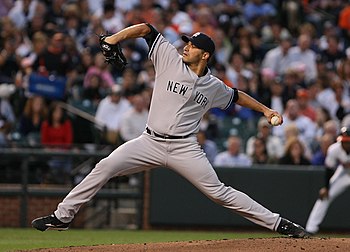
| Credit: Keith Allison |
Andrew Eugene "Andy" Pettitte; born June 15, 1972) is an American former baseball starting pitcher who played 18 seasons in Major League Baseball (MLB), primarily for the New York Yankees. He also pitched for the Houston Astros. Pettitte won five World Series championships with the Yankees and was a three-time All-Star. He ranks as MLB's all-time postseason wins leader with 19.
Associated Wikimedia
The following Wikimedia Foundation sister projects provide more on this subject:
-
Commons
Free media repository -
Wikibooks
Free textbooks and manuals -
Wikidata
Free knowledge base -
Wikinews
Free-content news -
Wikiquote
Collection of quotations -
Wikisource
Free-content library -
Wikiversity
Free learning tools -
Wiktionary
Dictionary and thesaurus
More portals
- Portals with triaged subpages from June 2018
- All portals with triaged subpages
- Portals with no named maintainer
- Automated article-slideshow portals with 51–100 articles in article list
- Automated article-slideshow portals with 501–1000 articles in article list
- Random portal component with 41–50 available subpages
- Automated article-slideshow portals with 201–500 articles in article list
- Random portal component with 11–15 available subpages
- Random portal component with 21–25 available image subpages








